-
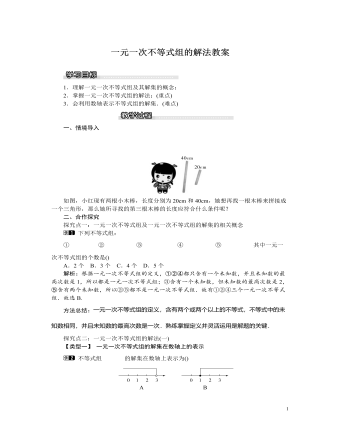
北师大初中八年级数学下册一元一次不等式组的解法教案
把解集在数轴上表示出来,并将解集中的整数解写出来.解析:分别计算出两个不等式的解集,再根据大小小大中间找确定不等式组的解集,再找出解集范围内的整数即可.解:x+23<1 ①,2(1-x)≤5 ②,由①得x<1,由②得x≥-32,∴不等式组的解集为-32≤x<1.则不等式组的整数解为-1,0.方法总结:此题主要考查了一元一次不等式组的解法,解决此类问题的关键在于正确解得不等式组或不等式的解集,然后再根据题目中对于解集的限制得到下一步所需要的条件,再根据得到的条件进而求得不等式组的整数解.三、板书设计一元一次不等式组概念解法不等式组的解集利用数轴确定解集利用口诀确定解集解一元一次不等式组是建立在解一元一次不等式的基础之上.解不等式组时,先解每一个不等式,再确定各个不等式组的解集的公共部分.
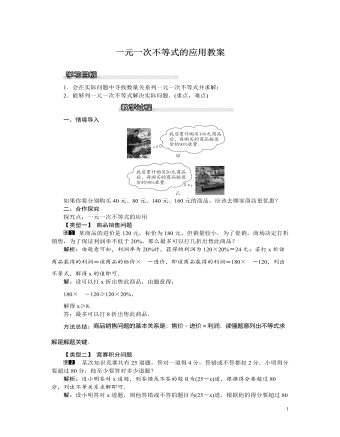
北师大初中八年级数学下册一元一次不等式的应用教案
有三种购买方案:购A型0台,B型10台;A型1台,B型9台;A型2台,B型8台;(2)240x+200(10-x)≥2040,解得x≥1,∴x为1或2.当x=1时,购买资金为12×1+10×9=102(万元);当x=2时,购买资金为12×2+10×8=104(万元).答:为了节约资金,应选购A型1台,B型9台.方法总结:此题将现实生活中的事件与数学思想联系起来,属于最优化问题,在确定最优方案时,应把几种情况进行比较.三、板书设计应用一元一次不等式解决实际问题的步骤:实际问题――→找出不等关系设未知数列不等式―→解不等式―→结合实际问题确定答案本节课通过实例引入,激发学生的学习兴趣,让学生积极参与,讲练结合,引导学生找不等关系列不等式.在教学过程中,可通过类比列一元一次方程解决实际问题的方法来学习,让学生认识到列方程与列不等式的区别与联系.
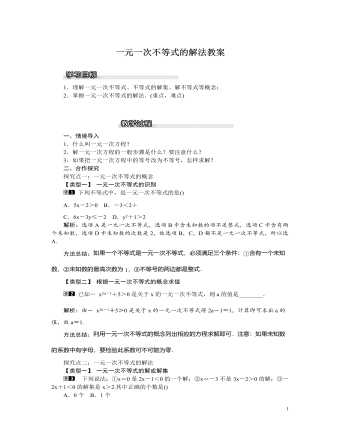
北师大初中八年级数学下册一元一次不等式的解法教案
方法总结:已知解集求字母系数的值,通常是先解含有字母的不等式,再利用解集唯一性列方程求字母的值.解题过程体现了方程思想.三、板书设计1.一元一次不等式的概念2.解一元一次不等式的基本步骤:(1)去分母;(2)去括号;(3)移项;(4)合并同类项;(5)两边都除以未知数的系数.本节课通过类比一元一次方程的解法得到一元一次不等式的解法,让学生感受到解一元一次不等式与解一元一次方程只是在两边都除以未知数的系数这一步时有所不同.如果这个系数是正数,不等号的方向不变;如果这个系数是负数,不等号的方向改变.这也是这节课学生容易出错的地方.教学时要大胆放手,不要怕学生出错,通过学生犯的错误引起学生注意,理解产生错误的原因,以便在以后的学习中避免出错.
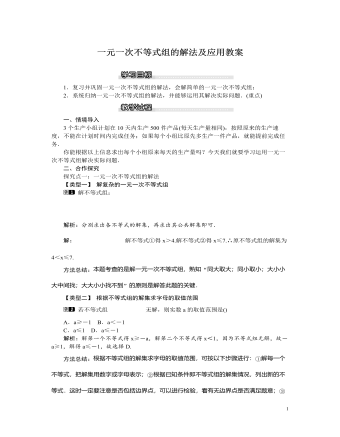
北师大初中八年级数学下册一元一次不等式组的解法及应用教案
安装及运输费用为600x+800(12-x),根据题意得4000x+3000(12-x)≤40000,600x+800(12-x)≤9200.解得2≤x≤4,由于x取整数,所以x=2,3,4.答:有三种方案:①购买甲种设备2台,乙种设备10台;②购买甲种设备3台,乙种设备9台;③购买甲种设备4台,乙种设备8台.方法总结:列不等式组解应用题时,一般只设一个未知数,找出两个或两个以上的不等关系,相应地列出两个或两个以上的不等式组成不等式组求解.在实际问题中,大部分情况下应求整数解.三、板书设计1.一元一次不等式组的解法2.一元一次不等式组的实际应用利用一元一次不等式组解应用题关键是找出所有可能表达题意的不等关系,再根据各个不等关系列成相应的不等式,组成不等式组.在教学时要让学生养成检验的习惯,感受运用数学知识解决问题的过程,提高实际操作能力.
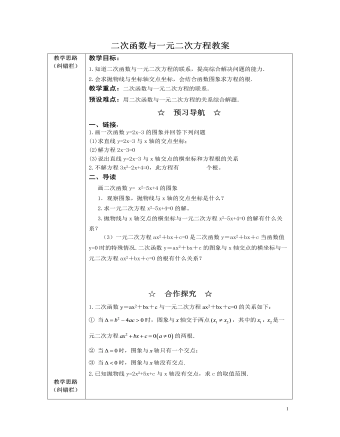
北师大初中九年级数学下册二次函数与一元二次方程2教案
教学目标:1.知道二次函数与一元二次方程的联系,提高综合解决问题的能力.2.会求抛物线与坐标轴交点坐标,会结合函数图象求方程的根.教学重点:二次函数与一元二次方程的联系.预设难点:用二次函数与一元二次方程的关系综合解题.☆ 预习导航 ☆一、链接:1.画一次函数y=2x-3的图象并回答下列问题(1)求直线y=2x-3与x轴的交点坐标; (2)解方程2x-3=0(3)说出直线y=2x-3与x轴交点的横坐标和方程根的关系2.不解方程3x2-2x+4=0,此方程有 个根。二、导读画二次函数y= x2-5x+4的图象1.观察图象,抛物线与x轴的交点坐标是什么?2.求一元二次方程x2-5x+4=0的解。3.抛物线与x轴交点的横坐标与一元二次方程x2-5x+4=0的解有什么关系?(3)一元二次方程ax2+bx+c=0是二次函数y=ax2+bx+c当函数值y=0时的特殊情况.二次函数y=ax2+bx+c的图象与x轴交点的横坐标与一元二次方程ax2+bx+c=0的根有什么关系?
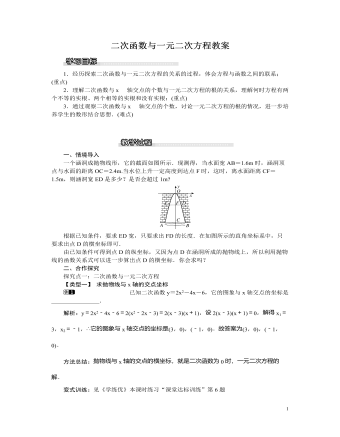
北师大初中九年级数学下册二次函数与一元二次方程1教案
解:(1)设第一次落地时,抛物线的表达式为y=a(x-6)2+4,由已知:当x=0时,y=1,即1=36a+4,所以a=-112.所以函数表达式为y=-112(x-6)2+4或y=-112x2+x+1;(2)令y=0,则-112(x-6)2+4=0,所以(x-6)2=48,所以x1=43+6≈13,x2=-43+6<0(舍去).所以足球第一次落地距守门员约13米;(3)如图,第二次足球弹出后的距离为CD,根据题意:CD=EF(即相当于将抛物线AEMFC向下平移了2个单位).所以2=-112(x-6)2+4,解得x1=6-26,x2=6+26,所以CD=|x1-x2|=46≈10.所以BD=13-6+10=17(米).方法总结:解决此类问题的关键是先进行数学建模,将实际问题中的条件转化为数学问题中的条件.常有两个步骤:(1)根据题意得出二次函数的关系式,将实际问题转化为纯数学问题;(2)应用有关函数的性质作答.
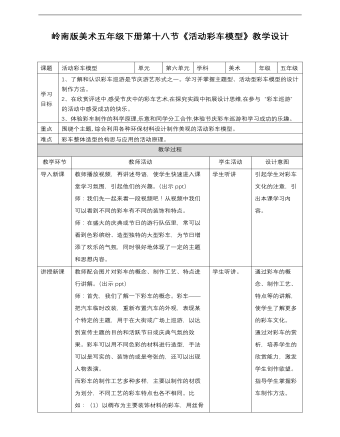
小学美术岭南版五年级下册《第六单元18活动彩车模型》教材教案
1、了解和认识彩车巡游是节庆游艺形式之一。学习并掌握主题型、活动型彩车模型的设计制作方法。 2、在欣赏评述中,感受节庆中的彩车艺术,在探究实践中拓展设计思维,在参与“彩车巡游”的活动中感受成功的快乐。 3、体验彩车制作的科学原理,乐意和同学分工合作,体验节庆彩车巡游和学习成功的乐趣。 围绕个主题,综合利用各种环保材料设计制作美观的活动彩车模型。 彩车整体造型的构思与应用的活动原理。 教师播放视频,再讲述导语,使学生快速进入课堂学习氛围,引起他们的兴趣。(出示ppt) 师:我们先一起来看一段视频吧!从视频中我们可以看到不同的彩车有不同的装饰和特点。 师:在盛大的庆典或节日的游行队伍里,常可以看到色彩缤纷、造型独特的大型彩车,为节日增添了欢乐的气氛,同时很好地体现了一定的主题和思想内容。
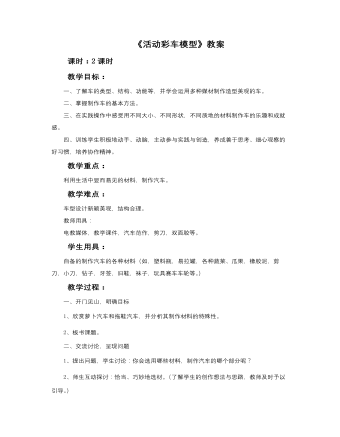
小学美术岭南版五年级下册《第六单元18活动彩车模型》教案
教学目标: 一、了解车的类型、结构、功能等,并学会运用多种媒材制作造型美观的车。 二、掌握制作车的基本方法。 三、在实践操作中感受用不同大小、不同形状,不同质地的材料制作车的乐趣和成就感。 四、训练学生积极地动手、动脑,主动参与实践与创造,养成善于思考、细心观察的好习惯,培养协作精神。 教学重点:利用生活中显而易见的材料,制作汽车。 教学难点:车型设计新颖美观,结构合理。 教师用具:电教媒体,教学课件,汽车范作,剪刀,双面胶等。学生用具:自备的制作汽车的各种材料(如,塑料瓶,易拉罐,各种蔬菜、瓜果,橡胶泥,剪刀,小刀,钻子,牙签,旧鞋,袜子,玩具赛车车轮等。) 教学过程: 一、开门见山,明确目标 1、欣赏萝卜汽车和拖鞋汽车,并分析其制作材料的特殊性。 2、板书课题。 二、交流讨论,呈现问题 1、提出问题,学生讨论:你会选用哪些材料,制作汽车的哪个部分呢? 2、师生互动探讨:恰当、巧妙地选材。(了解学生的创作想法与思路,教师及时予以引导。)

人教版新目标初中英语七年级下册What does he look like教案3篇
所需要用到的句子:Who is that?That is Jack. I like him.Why do you like him?I like him because he is interesting.Task 4: 设计理想中的人类Step one: 设计理想中的人类的外貌。把全班同学分成若干小组,学生可以边说边在纸上画出他们的模样。Step two: 设计理想中人类的性格。学生们可以把那些能描述性格的单词写在图画的旁边。Step three: 每组选出一名同学,其他同组同学提问,他作简单回答,并说明原因。所需用到的句子:What does he or she look like?He or she ...What is he or she like?He or she is ...Why?Because ...Task 5: 挑战性活动调查性格是天生的还是后天形成的,让每个同学回家去调查一下自己成长过程中性格是否有变化,具体是怎样的,为什么会这样? Teaching Aims:1. Enable students to have a general understanding of how to talk about people's physical appearance.2. Enable students to tackle some essential vocabularies and patterns about describing people. Provide them with necessary skills and methods.3. Create various chances for students to describe the persons they're familiar with, such as classmates, family members, teachers, idols, etc.

人教版新目标初中英语八年级下册If you go to the party, you’ll have a great time教案2篇
区分宾语从句、定于从句和状语从句宾语从句和状语从句,都叫做主从复合句。宾语从句主要是中考必考的,是初中阶段必掌握的从句,宾语从句主要是掌握三要素,所谓宾语从句,就是宾语在主从复合句当中充当宾语的一个句子,叫做宾语从句。主句的谓语动词是及物动词,后面如果是词或者是短语的话,是简单句,如果是句子的话,肯定是宾语从句。I know that he good at English.就是宾语从句,三要素,一要素是要注意连词,连词一共学了三类连词,一类连词是that口语当中可以省略,就像刚才说的那一句,I hear he is good at English.还有疑问代词、疑问副词,how where when,疑问代词、疑问副词。还有一类连词weather是否的意思,不是状语从句当中的如果,这一定要和如果区分开,这是是否。I don't know if he interested at English。宾语从句要注意if是连词。第二要素是语序,要用陈述举语序。比如说你家有几口人,我们都说How many people are there in you family?但是这是简单句,一旦说成宾语从句,你可以告诉我你家有几口人吗?Could you tell me how many people there are in you family ?

人教版新目标初中英语八年级下册It’s a nice day, isn’t it教案2篇
"Hello! Welcome to English class! Introduce yourself. Meet your new classmates." That's what the teacher says. What do you say? "Oh no!" It can be difficult talking to new people. But it can be fun, and you can make friends. How do you do it? Make small talk. Small talk is polite conversation. "Wang Nan is a great pingpang player, isn't she?" "I'd love to meet her, wouldn't you?" "It's been raining a lot, hasn't it?" Tag questions are a form of polite speech. To make small talk successfully, you should know how to make them. You should also know what topics to talk about. Try to learn this unit carefully. The next time you're in English class, you'll find out. Making small talk's easy, isn't it? (“你好!欢迎你!请做一下自我介绍。认识一下你的新同学。”通常在课上老师会这样说。你会说什么呢?“噢,不!”与陌生人谈话太困难了。但是这也很有意思,并且你还能交到朋友。你该怎么做呢?闲聊。闲聊指得是礼貌的对话。“王楠是一个很棒的乒乓球运动员,不是吗?”“我希望自己能认识她,你呢?“今年的雨水很多,不是吗?”反意疑问句是一种礼貌用语。为了使得谈话成功,你应该知道怎样去进行闲聊。你还应该知道与不同的人该谈论什么样的话题。认真的学习这个单元吧,下次在英语课上,你会发现与大家展开谈话是一件很容易的事情,不信我们来试试。)

人教版新目标初中英语八年级下册What were you doing when the UFO arrived教案2篇
(一).知识方面: 1.培养学生能运用过去进行时来描述、谈论过去某个时间正在发生的事情或动作的意识和能力,能就过去某个时间正在发生的动作做出正确的描述。 2.培养学生的想象力和角色扮演的合作能力。 3.培养学生讲述过去发生的事情经过的能力。能正确运用一般过去时来讲述故事。 (二).技能方面: 1.本单元的语言目标是Talk about past events and tell a story(谈论过去的时间和讲述一个故事),围绕这一目标,要涉及句型: What were you doing when the UFO arrived? ----I was sitting in the barber’s chair. The barber was cutting my hair. 因此必须学习standing、studying、cleaning、sleeping、cooking、making、eating、cutting、等表示地点的词,以便为上述句型提供语言材料。2.学习过去进行时的有关知识。Was/were+现在分词,是该时态的表达式。 3.在学习过程中,要区分The boy was walking down the street when the UFO landed.和While the boy was walking down the street, the UFO landed.这两种由when和while引导的状语从句的句型结构。注意它们的不同。

人教版新目标初中英语八年级下册Why don’t you get her a scarf教案
教师带领学生复习有关描述宠物的词汇,采用教师提问学生回答的方进行。如:T:What animals do you think would be good pets?What animals do you think would be bad pets?What do you think are good animals for a six-year-old child?然后学生进行 pairwork 练习。Task two: 师生互动,学习探究 1、播放3a部分的录音,引导学生一边听录音,一边跟读。2、通过听录音学生回答以下问题:Why do you think pot-bellied pigs are popular?What are the advantages and disadvantages of keeping such a pet?教师对学生的回答进行及时点评。3.学习范文,学习重点短语,为下步的模仿写作提供语言素材。T :1. )Have you ever kept a pig as a pet?Do you like pigs? St.:No.…Why don’t you like to keep a pig? St: No.They’re too dirty and lazy(Do you know in some foreign countries like Hollyland, Australia,pigs are the most popular pet.there’s a kind of pig.(图)it has an interesting name? it ‘s called a pot-bellied pig.) Now,let’s learn an article about this kind of interesting pet.2.)play the tapeSt.:Listen and repeat3.)show some Qs on computer(本子St.: read silently,then answerthe Qs(本子)4.)Ask ss. Close book and retell this passage.(what is a pot-bellied pig? Is it a good or bad pet? ) St.: retell it to each other“A pot –bellied pig is a popular pet now…”5.read the article together.St.:.practice reading

人教版新目标初中英语九年级下册I’ll help clean up the city parks教案
Talk about offering help (P60)I’ll help clean up the city parks.A: I’d like to work ...B: You could help ...Talk about ways to tell people about the Clean-Up Day (P61)We need to ...We can’t ...I’ll ...Talk about the work the volunteers do (P62)These three students all volunteer their time to help other people.Somebody loves to ... / helps ... / plans to ... / wants to ...A: What do you like doing?B: I like ... A: What kind of volunteer work do you think I could do?B: You could ...1. 重点词汇advertisement, fix, repair, pleasure, blind, deaf, shut, carry, specially, fetch2. 认读词汇hunger, homeless, cheer, clean-up, sign, establish, major, commitment, elementary, veterinarian, coach, similar, call-in, strategy, disabled, organization, unable, support, appreciate, donation, part of speech, pronoun, adverb, preposition, conjunction, donate, Jimmy, Sally3. 词组clean up, cheer up, give out, put off, set up, think up, take after, fix up, give away, put up, hand out, work out, at once

人教版新目标初中英语九年级下册You’re supposed to shake hands教案
教学目标:1. 掌握本单元一些重点词汇的写法和用法。2. 学会自如谈论餐桌礼仪。Step 1 RevisionAsk some students to retell the customs at the table in France in the passage in 3a.Step 2 Self checkPart 1. Fill in each bland with the correct word given. Students do the exercises by themselves at first. Then check the answers. Ask the students to comprehend the sentences and help them point out uses of some words, like “arrive (at / in) sw., spend time / money on sth , spend time / money (in) doing sth.”Part 2. Read about Fan Ling’s experience in a western restaurant. Understand the passage. Point out some key points in the passage.1. be / get used to doing sth. 习惯做某事2. begin with = start with 以….开头3. crowd v. 挤满,塞满 the crowd 人群 crowded adj. 拥挤的Then students discuss about how she would solve her problem. Ask some to share their stories with others.Part 3. Complete the crossword by looking at the sentences on the left. Then check the answers.

人教版新目标初中英语七年级下册How was your weekend教案2篇
Teaching Goal:1. General aims:Talk about recent past events2. Particular aims:A. Language Focus.Talk about recent past events and think of the past events.B. Language goalsHow was….?It was …What did …do over the weekend?C. Language structures:(1). How was your weekend? I was great. Pay attention to no form.(2). What did you do over the weekend? I played soccer. We went to the beach.D. Useful words and phrases:Words: was, did, went, beach, over, project, test, wasn’t, false, number, geography, spend, week, most, mixture, their, had, little, cook, read, saw, change, everyone, sit, sat, no, anythingPhrases: did one’s homework, played soccer, cleaned my room, went to the beach, played tennis, went to the movies, on Saturday morning, over the weekend, cook … for, what about, do some reading, have a party, talk show, go shoppingE. Grammar language:Present simple past tenseRegular and irregular verbsF. Learning strategies:Tour and holidaysG. Interdiscipinary:H. Emotion and manner:Teaching time: 5 periodsTeaching procedures:Period One教学步骤、时间 教师活动 学生活动 媒体应用Step 1Free talk 3’ Ask some questions like:Who’s on duty today?What’s the weather like? Answer and talk about something.让同学们回答下列问题1. Do you like weekend? (Let some students answer)It takes them three minutes to talk about the question.2. Why do you like weekend? (let the students answer) Most of the students like the weekend此时教师用汉语问:“在周末期间问你干了什么?这句话用英语这么回答?Let the students guess.At last the teacher give them right answer3. What did you do over the weekend?(板书、学习)

人教版新目标初中英语七年级下册Where is the post office教案2篇
Period 2 (3a----Section B 2c)Preview(Pre-task): Key points: What laAdd another information about their pen pals----their language on the cardnguage does she/he speak?She/He speaks....Does she/he have any brothers and sisters? Does she/he speak English?Preview(Pre-task): Add another information about their pen pals----their language on the cardKey points: What language does she/he speak?She/He speaks....Does she/he have any brothers and sisters? Does she/he speak English?Step 1 Revision1.Revisionand dictation of the new words 2.Revise the drills they learned yesterday.(by pairwork and grammar exercise)Step 2 Leading-inT has a conversation with one student. The conversation is following:---Do you have a pen pal?---Yes, I do.---What's your pen pal's name? ---His/Her name is....---Where is your pen pal from? ---He/She is from...---Where does he/she live? ---He/She lives in....---What language does he/she speak?He/She speaks...Write the new words on the Bb. They are following: EnglishChineseJapaneseFrenchStep 3 LearnLearn the new words with the whole class.Finish 3a with the students3b Pairwork T still does an example with one student Then the Ss practise in pairs. The example is following:--Curry Muray is my pen pal. He is from the United States.---What language does he speak?

人教版新目标初中英语七年级下册Don’t eat in class教案2篇
Don’t fight. =You can’t fight. (板书,教读)教师把这些句子板书在黑板上,并请学生大声整齐地读祈使句和“can’t”句型,并让学生注意两种句型表达形式的不同和转换,“Don’t …=You can’t…”;并对学生说:These are our school rules. (板书,教读) You can’t break the school rules. Don’t break the school rules.(板书,教读)步骤3 :Practicea. T: Now, each of the students is breaking one of these rules.Please finish 1a.学生看图,完成1a的内容,检查答案并大声朗读校规。b. 听录音,完成1b,选出四位学生都违反了哪条校规;听之前,学生要读会英文名。c. 请两位学生朗读1c部分的句型;要求学生两人一组对话表演,SA扮演外校转来新生,SB告知本校校规。(学生可经过讨论,多说出他们想到的校规,不必只限于书上;教师应给予帮助)2) 第二课时(2a~4)步骤1 :warming up of revisionT: What are the rules at your school?学生使用“can”或祈使句表达各条校规;其中老师可引出“eat in the cafeteria outside”的表达。步骤2 :Practicea.T: Christina is an exchange student. She doesn’t know the rules. Let’s listen, what activities they’re talking about?学生听第一遍时,完成2a;第二遍时,完成2b;b. 请学生领读2c部分,看着2a完成的表格,理解2c活动的要求;分成小组针对2a进行问答;

人教版新目标初中英语七年级下册I ’d like some noodles教案
教学过程Step 1: warming-up Sing a song---------“food and drink” Step 2: Revision1 Dictation2 Revise: What kind of noodles would you like?I’d like …What size bowl of noodles would you like?I’d like…Step 3: Presentation1 show pictures of food, ask students say the words.2 Students read the newspaper ad in 3a. Fill in blanks with words in the box. Then read the ad together, the teacher explains some difficult language points.3 Check the answers Step 4 PracticeAsk students to finish 3b in the same way according to 3a. Students read the short passage and fill in the blanks .At last, check the answers.Step 5 productionAsk students to write their own ad for dumplings, noodles, drinks, and other foods they know. Then ask students to read their partner’s ad. Then order food and drink from their partner.Step 6 Home workGroup work – make an ad about “food and drink”

人教版新目标初中英语七年级下册I want to be an actor教案2篇
三、教学建议第一课时:1. Lead in (Vocabulary)A) Before class, teacher should collect some pictures of working places. For example: Bank, TV Station, Restaurant, Police Station, Hospital ...B) In class, show students the pictures (PowerPoint, OHP). Ask students to tell the name of the working places and the name of the jobs.Shop assistant, doctor, actor, reporter, police office, waiter, bank clerk, studentC) Do exercise 1a and 3a.2. Bingo GameAsk groups of students to make up pairs of cards with a job on one and the related workplace on the other. For example, waiter / restaurant, teacher / school, doctor / hospital. Encourage students to use both the job / workplace combinations in the book and the ones that students came up during class discussions. Be sure they have twice as many sets of cards as there are students in the group. They can make two sets of cards for a single job / workplace, if necessary. Then have each group mix up its set of cards and hand their cards out in random order. Each time a student gets a pair of cards that match, he or she can lay these cards down. The goal is to have no cards in your hand at the end.3. Task OneA) Ask students to work in pairs and ask the partner what does he / she want to be in the future.e. g. :What do you / does he / does she want to be?I want to be a.Why?Because it's (adj).B) Vocabulary: Section B, 1a4. Homework 1.2.